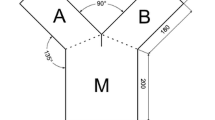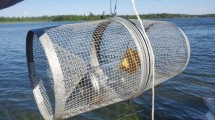Abstract
Water is vital for mammals. Yet, as ephemeral sources can be difficult to find, it raises the question, how do mammals locate water? Elephants (Loxodonta africana) are water-dependent herbivores that possess exceptional olfactory capabilities, and it has been suggested that they may locate water via smell. However, there is no evidence to support this claim. To explore this, we performed two olfactory choice experiments with semi-tame elephants. In the first, we tested whether elephants could locate water using olfactory cues alone. For this, we used water from two natural dams and a drinking trough utilised by the elephants. Distilled water acted as a control. In the second, we explored whether elephants could detect three key volatile organic compounds (VOCs) commonly associated with water (geosmin, 2-methylisoborneol, and dimethyl sulphide). We found that the elephants could locate water olfactorily, but not the distilled water. Moreover, they were also able to detect the three VOCs associated with water. However, these VOCs were not in the odour profiles of the water sources in our experiments. This suggests that the elephants were either able to detect the unique odour profiles of the different water sources or used other VOCs that they associate with water. Ultimately, our findings indicate that elephants can locate water olfactorily at small spatial scales, but the extent to which they, and other mammals, can detect water over larger scales (e.g. km) remains unclear.



Similar content being viewed by others
Data availability
Upon publication, all data will be available from the Dryad Digital Repository: https://doi.org/10.5061/dryad.h9w0vt4hc.
References
Al-Toum MO, Al-Johany AM (2000) Water deprivation and its effect on some blood constituents in Idmi Gazelle, Gazella gazella. J Arid Environ 45:253–262. https://doi.org/10.1006/jare.1999.0606
Asquith E, Evans C, Dunstan RH, Geary P, Cole B (2018) Distribution, abundance and activity of geosmin and 2-methylisoborneol-producing Streptomyces in drinking water reservoirs. Water Res 145:30–38. https://doi.org/10.1016/j.watres.2018.08.014
Aydin YM et al (2014) Biogenic volatile organic compound (BVOC) emissions from forested areas in Turkey: Determination of specific emission rates for thirty-one tree species. Sci Total Environ 490:239–253. https://doi.org/10.1016/j.scitotenv.2014.04.132
Bates LA, Sayialel KN, Njiraini NW, Moss CJ, Poole JH, Byrne RW (2007) Elephants classify human ethnic groups by odor and garment color. Curr Biol 17:1938–1942. https://doi.org/10.1016/j.cub.2007.09.060
Bates LA, Sayialel KN, Njiraini NW, Poole JH, Moss CJ, Byrne RW (2008) African elephants have expectations about the locations of out-of-sight family members. Biol Lett 4:34–36. https://doi.org/10.1098/rsbl.2007.0529
Bax PN, Sheldrick DLW (1963) Some preliminary observations on the food of elephant in the Tsavo Royal National Park (East) of Kenya. Afr J Ecol 1:40–51. https://doi.org/10.1111/j.1365-2028.1963.tb00177.x
Bear IJ, Thomas RG (1964) Nature of argillaceous odour. Nature 201:993–995. https://doi.org/10.1038/201993a0
Bechard MJ, Rayburn WR (1979) Volatile organic sulfides from freshwater algae. J Phycol 15:379–383. https://doi.org/10.1111/j.1529-8817.1979.tb00708.x
Biau G (2012) Analysis of a random forests model. J Mach Learn Res 13:1063–1095
Cain JW, Krausman PR, Rosenstock SS, Turner JC (2006) Mechanisms of thermoregulation and water balance in desert ungulates. Wildl Soc Bull 1973–2006(34):570–581. https://doi.org/10.2193/0091-7648(2006)34[570:MOTAWB]2.0.CO;2
Chamaillé-Jammes S, Fritz H, Murindagomo F (2007) Climate-driven fluctuations in surface-water availability and the buffering role of artificial pumping in an African savanna: Potential implication for herbivore dynamics. Austral Ecol 32:740–748. https://doi.org/10.1111/j.1442-9993.2007.01761.x
Chamaillé-Jammes S, Mtare G, Makuwe E, Fritz H (2013) African elephants adjust speed in response to surface-water constraint on foraging during the dry-season. PLoS ONE 8:e59164. https://doi.org/10.1371/journal.pone.0059164
Chong J, Xia J (2018) MetaboAnalystR: an R package for flexible and reproducible analysis of metabolomics data. Bioinformatics 34:4313–4314. https://doi.org/10.1093/bioinformatics/bty528
Garstang M et al (2014) Response of African Elephants (Loxodonta africana) to seasonal changes in rainfall. PLoS ONE 9:e108736. https://doi.org/10.1371/journal.pone.0108736
Gaylard A, Owen-Smith N, Redfern JV (2003) Surface water availability: implications for heterogeneity and ecosystem processes. In: du Toit JT, Rogers KH, Biggs HC (eds) The Kruger experience: ecology and management of savanna heterogeneity. Island Press, Washington, pp 171–188
Gerber NN (1967) Geosmin, an earthy-smelling substance isolated from actinomycetes. Biotechnol Bioengin 9:321–327. https://doi.org/10.1002/bit.260090305
Izaguirre G, Hwang CJ, Krasner SW, McGuire MJ (1982) Geosmin and 2-methylisoborneol from cyanobacteria in three water supply systems. Appl Environ Microbiol 43:708–714. https://doi.org/10.1128/AEM.43.3.708-714.1982
Jenkins D, Medsker LL, Thomas JF (1967) Odorous compounds in natural waters. Some sulfur compounds associated with blue-green algae. Environ Sci Technol 1:731–735. https://doi.org/10.1021/es60009a005
Jüttner F, Watson SB (2007) Biochemical and ecological control of geosmin and 2-methylisoborneol in source waters. Appl Environ Microbiol 73:4395–4406. https://doi.org/10.1128/aem.02250-06
Kessner D, Chambers M, Burke R, Agus D, Mallick P (2008) ProteoWizard: open source software for rapid proteomics tools development. Bioinformatics 24:2534–2536. https://doi.org/10.1093/bioinformatics/btn323
Kihwele ES et al (2020) Quantifying water requirements of African ungulates through a combination of functional traits. Ecol Mono 90:e01404. https://doi.org/10.1002/ecm.1404
Maltz E, Shkolnik A (1980) Milk Production in the Desert: Lactation and Water Economy in the Black Bedouin Goat. Physiol Zool 53:12–18. https://doi.org/10.1086/physzool.53.1.30155770
Marneweck C, Jürgens A, Shrader AM (2018) Ritualised dung kicking by white rhino males amplifies olfactory signals but reduces odour duration. J Chem Ecol 44:875–885. https://doi.org/10.1007/s10886-018-0988-3
McArthur C, Finnerty PB, Schmitt MH, Shuttleworth A, Shrader AM (2019) Plant volatiles are a salient cue for foraging mammals: elephants target preferred plants despite background plant odour. Anim Behav 155:199–216. https://doi.org/10.1016/j.anbehav.2019.07.002
McKee CJ et al (2015) Spatial distributions and resource selection by mule deer in an arid environment: Responses to provision of water. J Arid Environ 122:76–84. https://doi.org/10.1016/j.jaridenv.2015.06.008
Naidoo R et al (2020) Mapping and assessing the impact of small-scale ephemeral water sources on wildlife in an African seasonal savannah. Ecol Applic 30:e02203. https://doi.org/10.1002/eap.2203
Nevitt GA, Bonadonna F (2005) Sensitivity to dimethyl sulphide suggests a mechanism for olfactory navigation by seabirds. Biol Lett 1:303–305. https://doi.org/10.1098/rsbl.2005.0350
Nevo O, Schmitt MH, Ayasse M, Valenta K (2020) Sweet tooth: Elephants detect fruit sugar levels based on scent alone. Ecol Evol 10:11399–11407. https://doi.org/10.1002/ece3.6777
Niimura Y, Matsui A, Touhara K (2014) Extreme expansion of the olfactory receptor gene repertoire in African elephants and evolutionary dynamics of orthologous gene groups in 13 placental mammals. Genome Res 24:1485–1496. https://doi.org/10.1101/gr.169532.113
Noda M, Sakuta H (2013) Central regulation of body-fluid homeostasis. Trends Neurosci 36:661–673. https://doi.org/10.1016/j.tins.2013.08.004
Owen-Smith N (1996) Ecological guidelines for waterpoints in extensive protected areas. S Afr J Wildl Res 26:107–112. https://doi.org/10.10520/EJC117014
Polansky L, Kilian W, Wittemyer G (2015) Elucidating the significance of spatial memory on movement decisions by African savannah elephants using state–space models. Proc Royal Soci B 282:20143042. https://doi.org/10.1098/rspb.2014.3042
Presotto A, Fayrer-Hosken R, Curry C, Madden M (2019) Spatial mapping shows that some African elephants use cognitive maps to navigate the core but not the periphery of their home ranges. Anim Cogn 22:251–263. https://doi.org/10.1007/s10071-019-01242-9
Ramey EM, Ramey RR, Brown LM, Kelley ST (2013) Desert-dwelling African elephants (Loxodonta africana) in Namibia dig wells to purify drinking water. Pachyderm 53:66–72
Redfern JV, Grant R, Biggs H, Getz WM (2003) Surface-water constraints on herbivore foraging in the Kruger National Park, South Africa. Ecology 84:2092–2107. https://doi.org/10.1890/01-0625
Redfern JV, Grant CC, Gaylard A, Getz WM (2005) Surface water availability and the management of herbivore distributions in an African savanna ecosystem. J Arid Environ 63:406–424. https://doi.org/10.1016/j.jaridenv.2005.03.016
Rizvanovic A, Amundin M, Laska M (2012) Olfactory discrimination ability of Asian Elephants (Elephas maximus) for structurally related odorants. Chem Senses 38:107–118. https://doi.org/10.1093/chemse/bjs097
Schmitt MH, Shuttleworth A, Ward D, Shrader AM (2018) African elephants use plant odours to make foraging decisions across multiple spatial scales. Anim Behav 141:17–27. https://doi.org/10.1016/j.anbehav.2018.04.016
Shoshani J, Foley C (2000) Frequently asked question about elephants. Elephant 2:78–87. https://doi.org/10.22237/elephant/1521732268
Shoshani J, Kupsky WJ, Marchant GH (2006) Elephant brain. Part I: gross morphology, functions, comparative anatomy, and evolution. Brain Res Bull 70:124–157. https://doi.org/10.1016/j.brainresbull.2006.03.016
Shrader AM, Kotler BP, Brown JS, Kerley GIH (2008) Providing water for goats in arid landscapes: effects on feeding effort with regard to time period, herd size and secondary compounds. Oikos 117:466–472. https://doi.org/10.1111/j.2007.0030-1299.16410.x
Silanikove N (1992) Effects of water scarcity and hot environment on appetite and digestion in ruminants: a review. Livest Prod Sci 30:175–194. https://doi.org/10.1016/S0301-6226(06)80009-6
Smit IPJ, Grant CC, Devereux BJ (2007) Do artificial waterholes influence the way herbivores use the landscape? Herbivore distribution patterns around rivers and artificial surface water sources in a large African savanna park. Biol Cons 136:85–99. https://doi.org/10.1016/j.biocon.2006.11.009
Suffet IH, Schweitze L, Khiari D (2004) Olfactory and chemical analysis of taste and odor episodes in drinking water supplies. Rev Environ Sci Biotech 3:3–13. https://doi.org/10.1023/B:RESB.0000040012.94870.48
Tautenhahn R, Patti GJ, Rinehart D, Siuzdak G (2012) XCMS Online: a web-based platform to process untargeted metabolomic data. Anal Chem 84:5035–5039. https://doi.org/10.1021/ac300698c
Thrash I, Theron GK, Bothma JdP (1995) Dry season herbivore densities around drinking troughs in the Kruger National Park. J Arid Environ 29:213–219. https://doi.org/10.1016/S0140-1963(05)80091-6
Tsalyuk M, Kilian W, Reineking B, Getz WM (2019) Temporal variation in resource selection of African elephants follows long-term variability in resource availability. Ecol Mono 89:e01348. https://doi.org/10.1002/ecm.1348
Tshipa A et al (2017) Partial migration links local surface-water management to large-scale elephant conservation in the world’s largest transfrontier conservation area. Biol Cons 215:46–50. https://doi.org/10.1016/j.biocon.2017.09.003
Valenta K, Schmitt MH, Ayasse M, Nevo O (2021) The sensory ecology of fear: African elephants show aversion to olfactory predator signals. Cons Sci Prac 3:e333. https://doi.org/10.1111/csp2.333
Valls-Fox H et al (2018a) Water and cattle shape habitat selection by wild herbivores at the edge of a protected area. Anim Cons 21:365–375. https://doi.org/10.1111/acv.12403
Valls-Fox H, De Garine-Wichatitsky M, Fritz H, Chamaillé-Jammes S (2018b) Resource depletion versus landscape complementation: habitat selection by a multiple central place forager. Landsc Ecol 33:127–140. https://doi.org/10.1007/s10980-017-0588-6
von Dürckheim KEM et al (2018) African elephants (Loxodonta africana) display remarkable olfactory acuity in human scent matching to sample performance. Appl Anim Behav Sci 200:123–129. https://doi.org/10.1016/j.applanim.2017.12.004
Western D (1975) Water availability and its influence on the structure and dynamics of a savannah large mammal community. E Afr Wildl J 13:265–286. https://doi.org/10.1111/j.1365-2028.1975.tb00139.x
Young WF, Horth H, Crane R, Ogden T, Arnott M (1996) Taste and odour threshold concentrations of potential potable water contaminants. Water Res 30:331–340. https://doi.org/10.1016/0043-1354(95)00173-5
Acknowledgements
We thank S. Hensman and the rest of the team at Adventures with Elephants for allowing us to run the experiments. T. Bester and M. Schmitt assisted with data collection, and J. Joubert helped with the analysis of VOCs. J. Katz and three anonymous reviewers provided valuable comments on the manuscript.
Funding
The work was supported by the University of Pretoria to AMS and the French Agence Nationale de la Recherche [ANR-16-CE02-0001-01] to SCJ.
Author information
Authors and Affiliations
Contributions
M.W., S. C-J and A.M.S conceived the ideas, designed the methodology, and led the writing of the manuscript. M.W. and A.M.S. collected and analysed the data. A.H. conducted and interpreted the olfactory analysis. All authors contributed critically to the drafts.
Corresponding author
Ethics declarations
Conflict of interest
The authors have no conflict of interest to declare.
Ethical approval
All animal experiments were approved by the University of Pretoria’s Animal Ethics Committee (reference number NAS075/2019) in compliance with South African laws and regulations.
Additional information
Publisher's Note
Springer Nature remains neutral with regard to jurisdictional claims in published maps and institutional affiliations.
Supplementary Information
Below is the link to the electronic supplementary material.
Rights and permissions
About this article
Cite this article
Wood, M., Chamaillé-Jammes, S., Hammerbacher, A. et al. African elephants can detect water from natural and artificial sources via olfactory cues. Anim Cogn 25, 53–61 (2022). https://doi.org/10.1007/s10071-021-01531-2
Received:
Revised:
Accepted:
Published:
Issue Date:
DOI: https://doi.org/10.1007/s10071-021-01531-2




